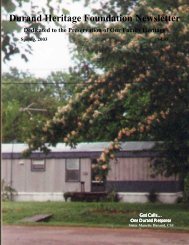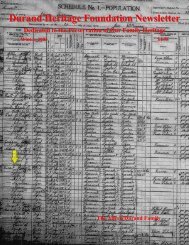Durand Heritage Foundation Newsletter
Durand Heritage Foundation Newsletter
Durand Heritage Foundation Newsletter
Create successful ePaper yourself
Turn your PDF publications into a flip-book with our unique Google optimized e-Paper software.
Summer, 2003 <strong>Durand</strong> <strong>Heritage</strong> <strong>Foundation</strong> <strong>Newsletter</strong><br />
I’ve been intrigued lately by a flicker of memory about<br />
something my father once said. In speaking of our<br />
French-Canadian ancestors he said that one of them had<br />
been given an island in the St. Lawrence River for fighting<br />
in a war. Like any kid I wondered if the island was<br />
still in the family and whether it might be named <strong>Durand</strong><br />
Island and whether we might secretly be rich. But<br />
in the atlas at our high school library I could find no <strong>Durand</strong><br />
Island and soon put the matter out of my mind.<br />
While looking at maps on the internet a year or so ago,<br />
however, I noticed a little island situated near the mouth<br />
of the Cap Rouge River, the area that I now know was<br />
where Jean <strong>Durand</strong> dit La Fortune acquired his first<br />
land. What got me looking, I think, was<br />
a passage I had read in Jean <strong>Durand</strong> et<br />
sa Posterité. Discussing the arrangement<br />
that Jean <strong>Durand</strong> made with a<br />
Charles Gautier (who was apparently<br />
Jean's boss for the three years he spent<br />
in military service) we read on page 20:<br />
"…Jean <strong>Durand</strong> receives on a three-year lease, from<br />
Charles Gautier called Boisverdun, a property situated at<br />
Cap-Rouge in the domain of Gaudarville, one part of<br />
which is farm land and the other is thickly wooded; a<br />
fishing location running in front of the land; and a small<br />
fort situated on an island."<br />
We can only speculate about why there was a small<br />
fort on what is a pretty small island, or how long the fort<br />
had been there. Perhaps it was built as a place of refuge<br />
design in case of Indian attack, or perhaps it mounted a<br />
cannon or two to protect the mouth of the Cap Rouge.<br />
Those speculations don't seem nearly as important to<br />
me as the speculation of how my father came to know of<br />
this island. Consider this:<br />
1. Jean <strong>Durand</strong> et sa Posterité had not yet been published,<br />
and chances are that my father would not have<br />
known about such a work-in-progress anyway.<br />
2. So far as I know, my father had never been to the<br />
Cap Rouge area or had any connection with our relatives<br />
there.<br />
3. Having completed only a few grades of school, my<br />
father was not a reader.<br />
So the question has been nagging—how did he know<br />
about that island?<br />
The distance between Jean <strong>Durand</strong> dit La Fortune and<br />
my father was eight generations, and our family line<br />
has, so far as I am aware, no family history that someone<br />
wrote between then and now. So I keep coming<br />
back to the thought that the story of this island must<br />
have been passed down from generation to generation<br />
by word of mouth—by storytelling.<br />
Along the way the story got a little garbled. The island<br />
was not a gift but a lease. And it was awarded to Jean<br />
<strong>Durand</strong> for his military service rather than his participation<br />
in a particular war. But if I'm right and the story of<br />
For What It’s Worth<br />
By John <strong>Durand</strong><br />
19<br />
this little island was indeed passed down in the family<br />
for more than 300 years—well, my jaw kind of dropped<br />
when I had that realization.<br />
Although I couldn’t attend the first meeting of what<br />
has become the <strong>Durand</strong> <strong>Heritage</strong> <strong>Foundation</strong>, I sent<br />
Mike <strong>Durand</strong> some thoughts before the meeting on the<br />
idea that, if we want to preserve our family history, we<br />
really have to start writing things down—stories about<br />
our uncles and aunts and grandparents, who’s who in<br />
the pictures we have, how did such a thing come to pass,<br />
and so on. What I said must have resonated with the 12<br />
people in attendance at that meeting, because they nominated<br />
me in absentia to be the vice-president of an asyet-undefined<br />
organization.<br />
Well, four years later we are a char-<br />
tered not-for-profit corporation with a<br />
certain amount of organization stability,<br />
but we are still trying to solve those<br />
same problems.<br />
• How do we preserve our family<br />
stories?<br />
• How do we preserve our family pictures?<br />
• How do we preserve our important family documents—birth<br />
certificates, marriage licenses,<br />
awards and achievements?<br />
I’m not talking about just the old-timey stuff—black<br />
and white studio portraits of stiff-looking, unsmiling<br />
strangers. I’m talking too about us and our kids and our<br />
grandkids. Let me give you an example of why I still<br />
think this idea is still important.<br />
Last summer I attended a family reunion in Saskatchewan,<br />
Canada of my mother’s family, the first reunion of<br />
that family in decades. A guy from Oklahoma shows up<br />
with a suitcase full of pictures passed down to him by<br />
his father. He had no idea who the people in the pictures<br />
were. Once again my jaw dropped. What he lugged up<br />
to Canada were beautifully preserved pictures of my<br />
parents and brothers and sisters and uncles and aunts<br />
and cousins. Some of these pictures I had never seen.<br />
Once again the lesson to me was that we need a context<br />
for the things we preserve. If we don’t have a context<br />
an old-timey picture isn’t worth much. It’s the stories<br />
about people and things that gives a picture value.<br />
Here’s another example. When my mother was very<br />
old and I began to realize that she was going to die with<br />
a wealth of information about her family, I made an effort<br />
to learn a lot more than I knew about her childhood<br />
and growing up. One of the stories she told me was that<br />
her family had so many chimney fires in their house that<br />
her father nailed a ladder to the roof so that he could<br />
quickly climb up the steep slope with a bucket of water<br />
to pour down the chimney. And sure enough, on several<br />
pictures of their house we see an incongruous metal ladder<br />
on the steep roof pointed towards the chimney. If we<br />
didn’t know why, we could only wonder it was there.




